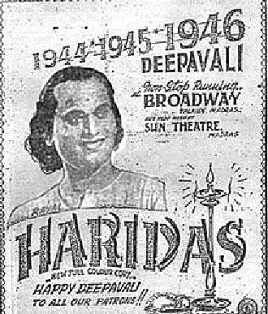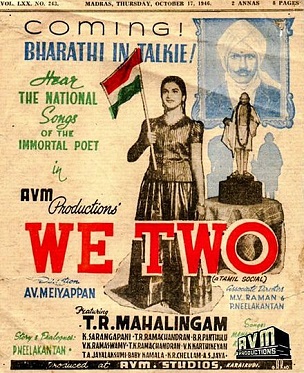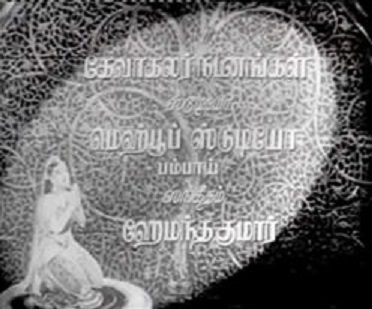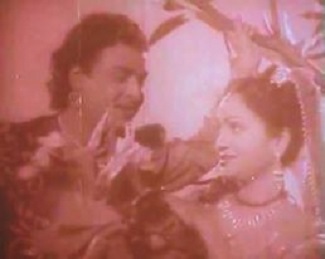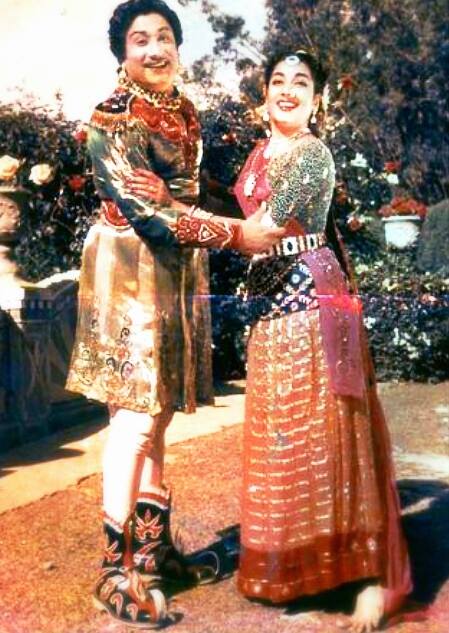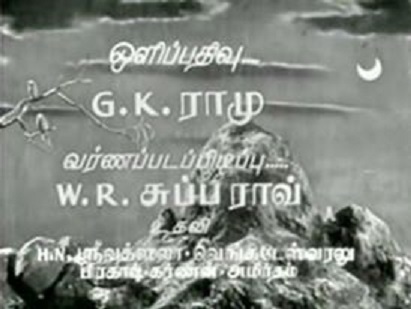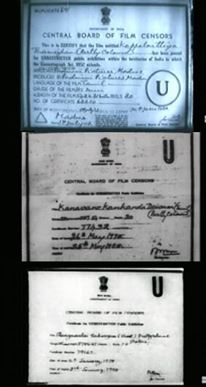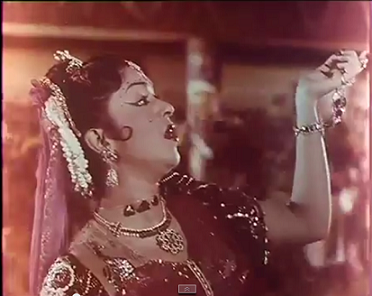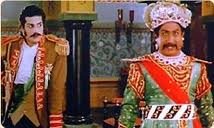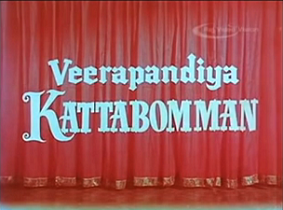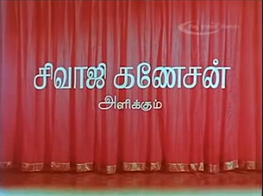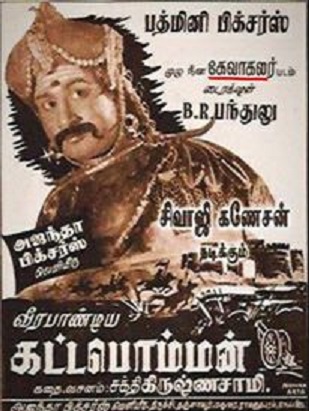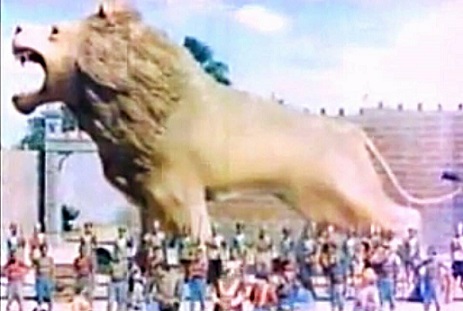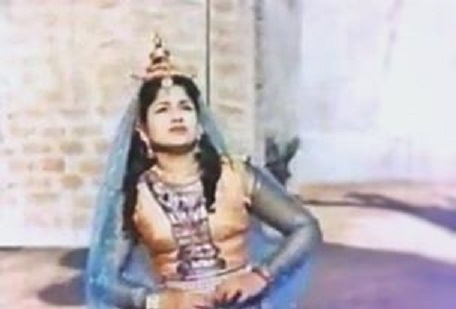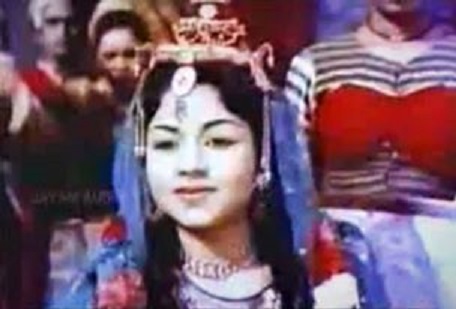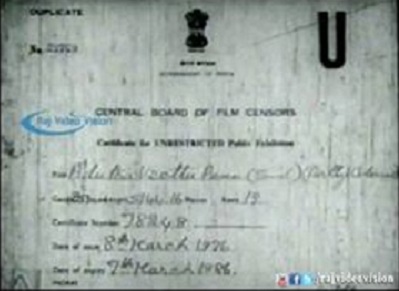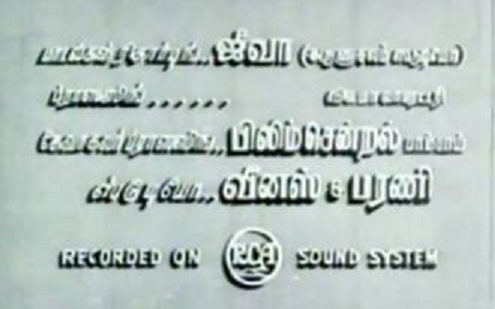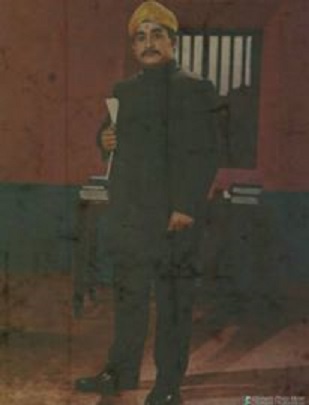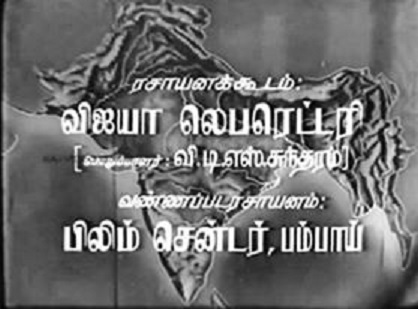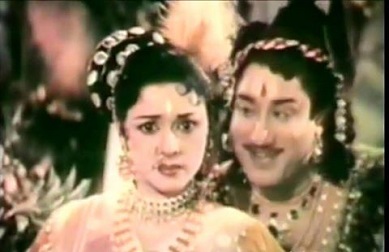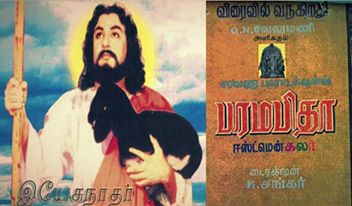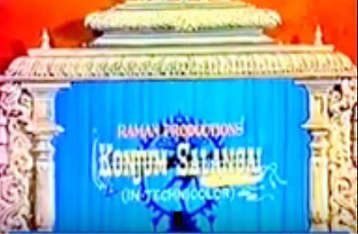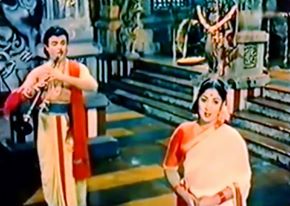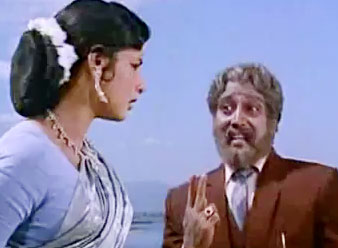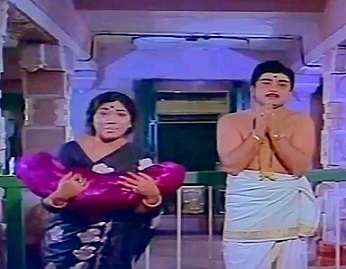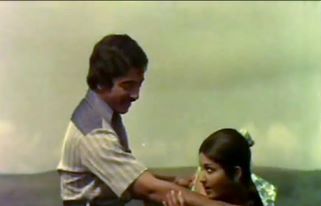Colour films in Tamil
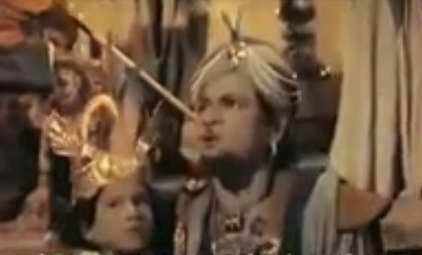
Maaya Mohini was the dubbed version of the 1956 Hindi-Urdu film Hatim Tai (music: SN Tripathi. The Hindi-Urdu original was sung by Rafi with the words "Parvar digar e aalam".
P Jairaj (playing Hatim Tai, above) was from Hyderabad and the heroine Krishna Kumari, though from Bengal, had acted in Telugu films. Therefore, too, Tamil audiences thought of Maaya Mohini as their own film, and not merely a dubbed version of North Indian film.l
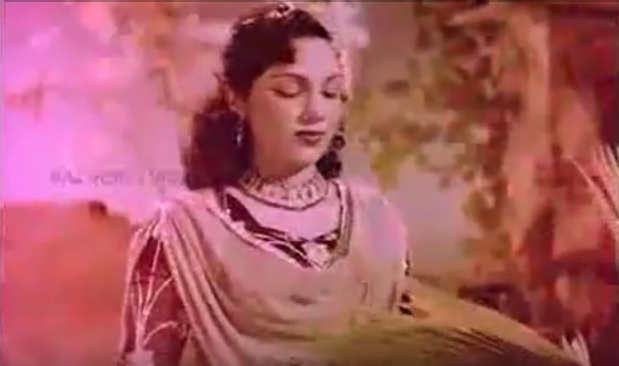
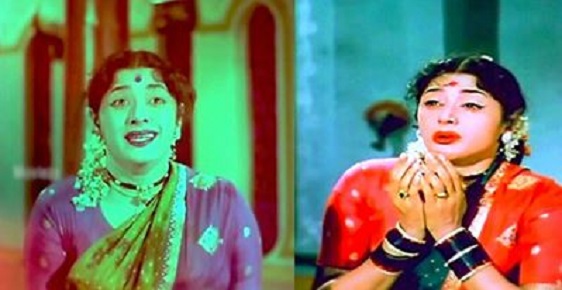
This two-part image shows the stark difference between prints in Geva Color (left) and prints in Technicolor (right). The colours of two freeze-frames from the same song reveal what a big difference the choice of the colour positive film made.
On the left, the heroine (Padmini) is seen wearing a dark pink blouse with a light green sari. On the right, the heroine wears a red blouse with a dark green sari. Red got reduced to pink and dark green to light green during the transition to Geva Color.
Frames assembled by Mr Sajeeth.
Readers can send additional information, corrections, photographs and even |
Contents |
The 1940s: Hand-tinted films
Sources: Chit Dukhira, LeMauricien
In the 1940s some films made in Bombay and Madras were ‘hand-tinted' This meant that human artists painted colours on every frame of the positive print with their hands. This was a tedious and labour-intensive procedure.
Artists needed specialised training so that the colours did not jump up and down from frame to frame. The Hindu informs us that, an 'advocate of Madras had a company undertaking ‘Hand Tinting,' and a technician Murugesan was expert at doing such sequences.'
K. Subramanyam's mythological Bhaktha Chetha (1940/ Tamil), starring Vethala had some tinted sequences.
Mangama Sabatham (1943/ Tamil) was the next with hand-tinted scenes. This, incidentally, was the debut film of Vasunthara Devi, the mother of actress Vaijayanthimala.
Haridas followed with hand-tinted scenes. The poster on this page suggests that the entire Haridas (1944) had been colourised.
Bhaskar Pictures' Saalivaahanan (1945/ Tamil/ dir B.N. Rao) had a romantic scene between Ranjan and T. R. Rajakumari (who played a princess) which was hand-tinted (The legendary M.G. Ramachandran played Vikramaditya, a villain in the film and Ranjan the eponymous hero, Saalivaahanan.)
Naam Iruvar (1947/Tamil) and Vedhala Ulagam (1948/Tamil) were among the last in Tamil to feature labour-intensive, hand-tinted colour scenes.
Dubbed colour films hit Tamil screens
Aan was the second Hindi-Urdu (indeed the second Indian) film to be released in colour, and the first successful one. Its Tamil version reached the state then called Madras shortly thereafter. It was an A list film. The Tamil versions of a number of B and C films originally made in Hindi-Urdu followed Aan.
The reason why B and C Hindi-Urdu films in colour were dubbed into Tamil, while A films were not could be that Hatim Tai, Zabak, Zimbo and Parasmani were all Arabian Nights-style ‘fantasy’ films, set in magical, mediæval times. Perhaps such films manage to cross cultural boundaries easier (think: Bahubali’s historic success) than serious A films.
Then how did Aan cross the same border? Because minus the fantasy part it, too, was a costume drama about kings, queens, villainous courtiers and heroic commoners.
It would not be wrong to call the films mentioned below ‘Tamil versions’ because once dubbed into Tamil they took on a life on their own. Their songs would later go on to become the stuff of nostalgia.
For instance, Maravene entha naalum from Maaya Mohini (1956) was sung by TM Soundararajan and set to the same tune as "Parvar digar e aalam" sung by Rafi. Even in the 21st century the song has a loyal following.
The list:
Aan (1952) (Tamil: Murattu Adiyaal) (Print by Technicolor)
Hatim Tai (Tamil: Maaya Mohini (1956) (Geva Color)
Zimbo (1959) (Geva Colour)
Zabak (Tamil: Arabu Naatu Azhagi) (Geva Colour) (1961) and
Parasmani (Tamil: Maaya Mani) (Partly in Eastman Colour) (1963)
Lava Kusha (1963) was simulateously made in Tamil and Telugu. This was the last Tamil film to be shot entirely in Geva colour.
The early years
From ‘Partly in Colour’ to Entire Film in Colour
Kalyanam Panni Paar (1952, Tamil) First Tamil and first South Indian film with a colour insert (the song "Engu Sendraayo").
Kanavaney Kankanda Deivam (1955/ Tamil) The song "Jagajothiye" and dance sequence in the climax were in colour
Alibabavum 40 Thirudargalum (1956/ Tamil ) first Tamil and South Indian full-length colour film.
Marma Veeran (1956/ Tamil ) Partly in colour
Kannin Manigal (1956/ Tamil ) Partly in colour
Thangamalai Ragasiyam (1957/ Tamil ) Had one photographer for the main black and white film and another for the song "Ehalogame", which was in Gevacolour
Ambikapathy (1957/ Tamil) Partly in colour
Allaudinum Arputha Vilakkum (1957/ Tamil ) Partly in colour
After this, there were several Tamil films that had a song—normally a dance accompanied by a song—in Gevacolor. Almost the entire second half of Nadodi Mannan (1958/ Tamil ) was in Gevacolor. In the late 1950s, every year there would be two or three Tamil films that were ‘partly in colour’—normally Gevacolor. The number of such films increased every year.
Veerapandiya Kattabomman (1959/ Tamil ) This entire magnum opus was in colour. The whole film was shot in Gevacolor but its prints were in Technicolor.
Athisaya Penn (1959/ Tamil ) The film was a remake of the Hindi film Aasha (1957). While most of the film was in Gevacolor, the 45-minute climax was in ‘scintillating Technicolor.’ Thus, this was the first Tamil film, the first South Indian film and, after Asha, the second Indian film a portion of which was shot in Technicolor.
Sri Valli (1961, Tamil) The film was entirely in Gevacolor
Lava Kusa (1963/ Tamil) This was the last Tamil film to be shot in Gevacolor
Geva brings colour to Tamil films
Kanavane Kankanda Deivam (1955) had some reels in GevaColor. No colour sequence from the film is available in the public domain. Its print on YouTube is entirely in black and white. The first of the two stills from the film on this page is clearly a black and white still colourised by hand ('hand tinted'). If the second still is indeed from the film, it would be a rare picture from the first Tamil film shot in colour, even if only partly.
Why, then, do we assert that Kanavane Kankanda Deivam was even partly in colour? Because its censor certificate says so. (Courtesy Mr Sajeeth)
The first Tamil film ‘entirely in colour’ was Alibabavum Narpadhu Thirudargalum (1956/ Geva Color).
Madurai Veeran (1956/Tamil) is said to have contained some colour scenes but this cannot be asserted with certainty because those scenes have not survived.
The few colour sequences in the film "Nadodi Mannan" (1958) were shot in GevaColor.
Technicolor
Prints in Technicolor
Veerapandiya Kattabomman (1959) is said to be the second Tamil film to be released in Technicolor. It was, like other Indian 'Technicolor' films before and after, printed in London.
Which was the first? Well, Nadodi Mannan (1958) had a colour (wrongly assumed to be Technicolor) sequence set on a tropical island. Its first half was in B/W but the second half in colour—in GevaColor. Therefore, Veerapandiya Kattabomman (1959) was the first Tamil film printed in 'Technicolor'.
The colours of much of Veerapandiya Kattabomman are quite weak, which is hardly characteristic of Technicolor. The three frames shown on this page, on the other hand, have the richness of Technicolor. Mr Sajeeth Lourdes writes, ‘The film Veerapandiya Kattabomman (1959) had sequences in both Technicolor and Geva Color. Because [of this] the colour in the film is uneven.’
That explains.
Now, if even one reel of Veerapandiya Kattabomman had been shot (and not merely printed) in Technicolor, that would make it the first in India to have been shot in Technicolor. By 1959 five Hindi-Urdu films had had prints in Technicolor or were in ‘Color by Technicolor.’ None claimed to have been shot in Technicolor. In Hindi-Urdu that honour belongs to Mughal-e-Azam (1960), two very long sequences of which were in colour: they were said to have been shot in Technicolor. Veerapandiya Kattabomman was released before Mughal-e-Azam.
If even one or two seconds from Veerapandiya Kattabomman had been shot in Technicolor, the history of Indian (not just Tamil) cinema would need to be re-written.
Mr Sajeeth has settled the controversy about Veerapandiya Kattabomman’s negative and positive films decisively with the poster of the film seen on this page. The poster clearly states (underlined in red) that Veerapandiya Kattabomman was shot in GevaColor.
Now, the film was not even printed fully in Technicolor.
Veerapandiya Kattabomman was shot entirely in Geva Color and then partially converted into Technicolor in Germany. Due to some financial problem, the film was not entirely converted into Technicolor. This caused the film's colours to be uneven. (The mega-budget Mother India, too, has uneven colours--most of them weak--though that film had no shortage of funds.)
Mr Sajeeth has demonstrated this in a two-part image from the song Pogathey Pogathey En Kanavaa (film: Veerapandiya Kattabomman). The said image can bee seen elsewhere on this page. It shows the stark difference between prints in Geva Color (left) and prints in Technicolor (right). The colours of the two freeze-frames from the same song reveal what a big difference the choice of the colour positive film made. On the left, the heroine (Padmini) is seen wearing a bluish pink blouse with a light green sari. On the right, the heroine wears a red blouse with a dark green sari. Red got reduced to pink and dark green to light green during the transition to GevaColor.
Konjum Salangai: Tamil's only, India's second Technicolor film
"Konjum Salangai" (1962) was Tamil Cinema's first and only film to have been shot entirely in Technicolor. It was released less than a year after India's first film shot entirely in Technicolor: Gunga Jumna (Hindi Urdu: 1961). Thanks to Mr Sajeeth’s painstaking efforts Konjum Salangai can be seen on YouTube, in fourteen parts. (In the early years of YouTube you could upload full films but had to chop the film up into sections and upload them one by one.) There were no Tamil films produced in Technicolor after this film.
The Technicolor process
Technicolor was expensive because the image being photographed (i.e. the light coming from this image) had to pass through three strips of black-and-white film. Together these three strips formed a rich colour image. This colour went by the brand name Technicolor.
The camera’s lens split the light coming from the actors and the background into two beams, one of which went through a green filter and the other through a magenta filter. The topmost strip could receive only blue light and recorded blue images. The green filter obstructed red and blue light; the second strip received this image. The magenta filter kept green light out; the third strip recorded the residual colours.
The cyan, magenta and yellow dye images from these three negatives were superimposed on a single strip of film, which resulted in sharp, nuanced Technicolor images.
Geva Color marches ahead steadily
Nadodiyin Magan (1959) was Part II of Nadodi Mannan. It is believed that the film was shot in colour but few know for sure because the film was never released.
Sri Valli (1961/ Tamil) was the sixth Tamil film with colour photography and the third full length colour film in Taml. This film was shot in Geva Color. The film "Sri Valli" (1961/Tamil) was shot entirely in Geva Color. However, the colours seen in this film, too, were uneven. The first quarter of the film had a poor colour quality while the rest of the film had merely satisfactory colours.
Lava Kusha (1963) was simulateously made in Tamil and Telugu. This was the last Tamil film to be shot entirely in Geva color.
What was Gevacolor?
Gevacolor was an inexpensive (and choppy) colour film invented in 1948 in Belgium. Its owners were a sister concern of the German company that made Agfacolor. After Germany was partitioned, Wolfen, the town where Agfacolor was produced, came to be in communist East Germany.
In 1964 the two companies formally merged to become Agfa-Gevaert. The equally downmarket Orwo (Original Wolfen) Colour, in which inexpensive Hindi-Urdu art and B and C films were made even in the 1980s, was produced at the same factory in Wolfen.
In India GevaColor products were licensed to Mr. Ambalal Jhaverbhai Patel, who owned the Film Centre laboratory where GevaColor was processed. He was also the Indian licencee of Polydor records (later called Music India Limited) and View Master 3D vewing toys for children.
Eastmancolor
Parma Pidha (1961/Tamil) starring MGR and Saroja Devi was announced to be shot in Eastman Color. This was the first Tamil film to be shot in Eastman Color. However, the film was never released.
The first Eastmancolor movie in Tamil to be actually released was the cheerful comedy Kathalikka Neramillai (We don't have any time for love I1964), a hit.
Technicolor vs. Eastmancolor
For a comparison between these two upmarket colour films, see the section ‘Technicolor vs. Eastmancolor...’ on the page Colour films in Hindi-Urdu. There are three illustrations that show how Eastmancolor is quite satisfactory to begin with but starts fading with age, and how Technicolor is much richer even initially and remains so decades later.
‘Partly in colour’
The economics of shooting three-hour long films entirely in colour for the relatively limited Tamil audience did not work out. Therefore, till the late 1960s even major Tamil films had only some reels in colour. Local posters of some such films would announce, ‘Songs and dances in colour.’ (Big-budget Tamil films were typically three hours long, vs. around fifteen or twenty minutes less in the case of Hindi-Urdu films)
The following films had some reels in the colours mentioned against their names
Kanavaney Kankanda Deivam (1955/ Tamil/ probably Geva Color. The first line of one of the screenshots on this page states that the film has dance sequences in Gevacolor.
Nadodi Mannan (1958/Tamil/ Geva Color),
Thangamalai Ragasiyam (1957/Tamil/ most likely Geva Color). Mr Sajeeth has sent Indpaedia a screenshot from the credit titles of Thangamalai Ragasiyam (1957/ Tamil). Its second line informs viewers that the film’s colour cinematography was by W. R. Subba Rao (வர்ணப்படப்பிடிப்பு W. R. சுப்ப ராவ்). This proves that Thangamalai Ragasiyam had colour sequences. Mr Sajeeth’s research indicates that the negatives were in Gevacolor, though the film’s credits do not make this clear.
There is debate about whether the negatives of Raja Malaya Simman (1959/Tamil and Telugu) were in Technicolor or Eastmancolor. If they were in Technicolor then this would have been the first use of Technicolor negative in an Indian film. Mughal-e-Azam’s (Hindi-Urdu) substantial colour portion was, as per available evidence, the first in India to be shot on Technicolor negative, and that film, long in the making, was released in 1960. Mr. Sajeeth believes that the colour film used in Raja Malaya Simman was Eastmancolor because the film was processed by Gemini Colour Laboratory. This is the most reasonable assumption. In that case Raja Malaya Simman would have pioneered Eaastmancolor in India. Hum Hindustani (Hindi-Urdu), India’s first full-length Eaastmancolor film, was released in 1960.
Adutha Veetu Penn (1960/Tamil/ Gevacolor)
Kappalottiya Tamizhan (1961/ Tamil) had colour inserts, which were processed at Film Centre, Bombay which used to process Gevacolor.
Veera Abhimanyu (1965/Tamil/ Eastmancolor),
Andharangam (1975/Tamil/ OrWo Color)
Thunaivan (1969/Tamil/ Eastmancolor).
(Why should anyone have to prove that a film was, or portions of it were, in colour? Can't we make out by simply looking at the film?
(No.
(Till at least the late 1960s, even big budget Hindi-Urdu films like Sawan ki Ghata (Eastmancolor) would have B&W/ 16mm prints for the army's field units and small Indian towns.
(Andrei Tarkovsky's Andrei Rublev [1966/ USSR) and the Dev Anand starrer Teen Deviyan (1965), too, originally had colour inserts. On Doordarshan the same inserts were shown in black and white. Clearly, someone along the line was insensitive to the director's vision.
(Many 'partly in colour' Tamil films have been uploaded on YouTube entirely in B&W. Mr Sajeeth teaches us how to find out which sequence in such films was supposed to be in colour: 'Notice the contrast of the film. In portions where the contrast gets reduced you can safely assume that that particular scene was originally in colour.'
OrWo comes to the rescue
Eastmancolour being expensive most middle- and low- budget Tamil films in the 1970s were shot in black and white. The birth of ORWO Colour brought the black and white era in Tamil Cinema to an end. Many films in the 1980s were shot in ORWO Colour.
Authorship
Sajeeth Naveen Lourdes, film historian
created this page by sending photographs and facts as messages to the Facebook community, Indpaedia.com.
You can help by sending additional information (including anecdotes and the names of actors) to Indpaedia.com
See also
Colour films in Hindi-Urdu This page illustrates, though photographs, the evolution of colour in Indian, and not just Hindi-Urdu, cinema
Colour films in Tamil
Colour films in Telugu This page has pictures from and factoids about bilingual Tamil-Telugu flms.
CinemaScope films in Bangladesh, India, Nepal, Pakistan, Sri Lanka I.e. the first part of this article
70mm films in India/ South Asia
Cinerama theatres in India, Pakistan, Sri Lanka
See also
Indpaedia has several articles about Tamil cinema. Some of the more popular ones are
The private lives of Tamil filmstars
